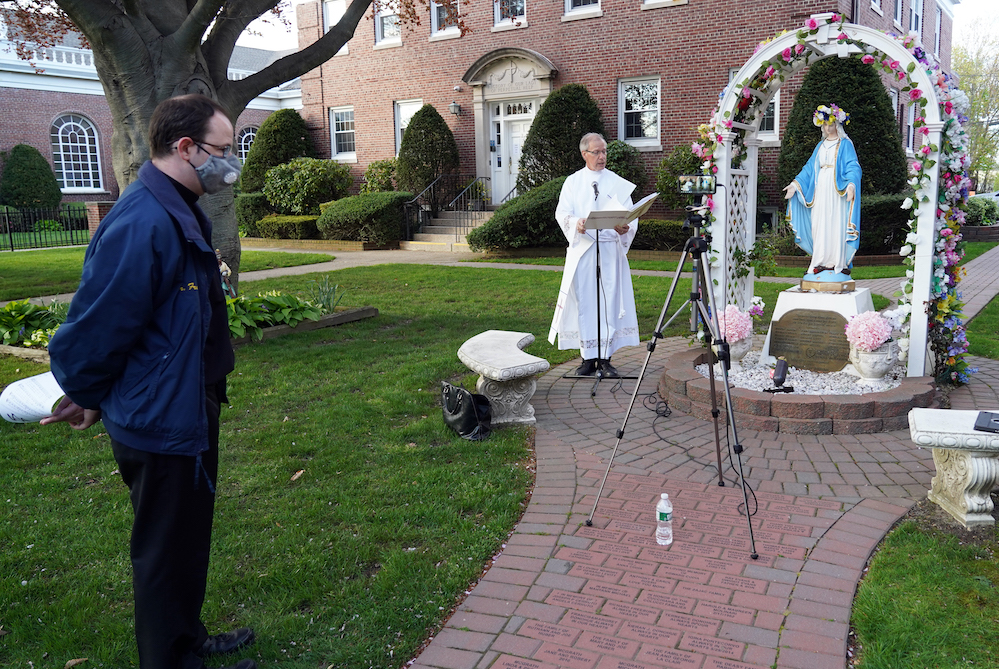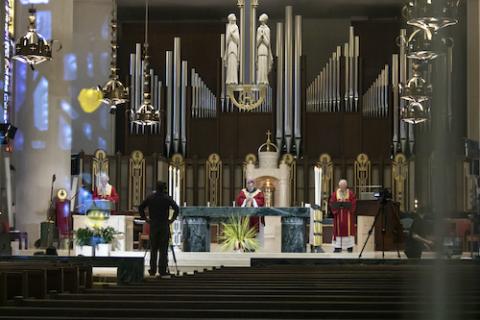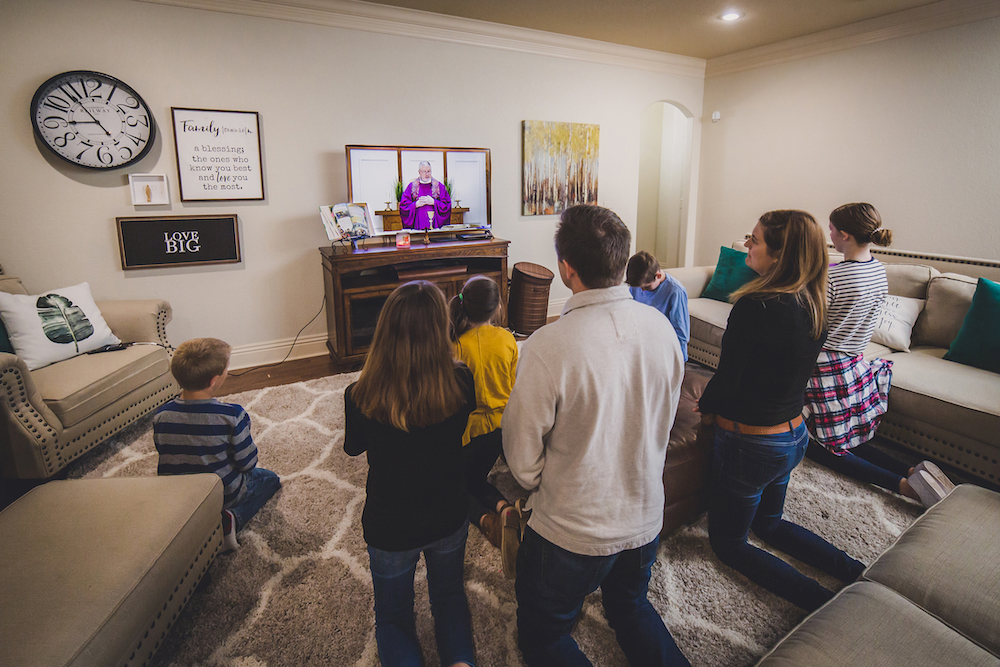
Deacon Robert Becker prays during a May Crowning ceremony May 2 at Our Lady of Perpetual Help Church in Lindenhurst, New York. Standing at a distance is Fr. Frank Zero. (CNS/Long Island Catholic/Gregory A. Shemitz)
In the interest of public health and safety as the current pandemic unfolded, our church leaders suspended the public celebration of Mass and asked priests to continue celebrating Mass without the presence of the faithful. They encouraged livestreaming these Masses.
Due to the urgency, this took place without much forethought: going remote, picking up worship as it is, and moving it online. But a different modality requires something different. Aware that this pandemic may go on for some time, the church needs to reflect on this experience and chart a course for how to respond to this and similar situations ahead.
The proliferation of Mass via livestream has created a nearly endless selection of livestream and pre-recorded Masses for the faithful who have access to internet and devices from the convenience of their own home, detached from their parishes.
Are such remote or virtual celebrations in fact authentic celebrations of the Eucharist? Do they promote the appearance that the bread and wine are the subject of the liturgy, rather than the assembled body of Christ?
What is the distinction between a rare use of virtual celebrations, and implementing them as normative, even if temporary? How might the church offer accompaniment and meaningful worship when priests and faithful cannot physically gather?
Advertisement
Full and active participation
Some of the widespread practices for to how to worship during this pandemic, such as asking priests to offer Mass without the faithful present and encouraging spiritual communion, are supported by a theology of the Eucharist shaped more by the Council of Trent than one that flows from the Second Vatican Council.
Vatican II's Constitution on the sacred liturgy, Sacrosanctum Concilium, offers a more mature theology of the Eucharist and is the bar against which we should consider our current situation.
The liturgy is not simply one form of prayer among others. As Sacrosanctum Concilium states, it "is the summit toward which the activity of the Church is directed; at the same time it is the font from which all her power flows."
Livestreaming and Zoom gatherings do indeed keep the community together, while providing solace and spiritual nourishment. However, the summit and font of our faith requires serious and intentional reflection to its spatial, physical and communal dimensions.
Perhaps the line that has most shaped the liturgical imagination of the post-conciliar church is the constitution's call that the laity should have "full, conscious, and active participation in liturgical celebrations." It further says that "the full and active participation by all the people is the aim to be considered before all else."
Do pre-recorded or even livestreamed Masses, lead to or even allow "full, conscious, and active participation" of the faithful?
Some people at home may be praying along throughout the Mass, while others are having breakfast, answering the phone or surfing the web. They may be watching, but are they actively participating?
Is the participation of the faithful necessary?
Sacrosanctum Concilium states clearly that "liturgical services are not private functions, but are celebrations of the Church… [and they] pertain to the whole body of the Church."
Livestreams often show empty churches with a lone presider — perhaps other clergy, possibly a reader, server and/or cantor. Clergy are exclusively male, and, too often, those chosen to perform lay ministries are as well. Such divisions present a church of gender exclusivity in this microcosm of the church celebrating its "sacrament of unity." Those at home see how easily a male dominated church excludes roles for women.
In a livestream Mass, the priest is the center, and the bread and wine appear the subject of the sacrament, disconnected from a gathered community of the baptized. Is it possible for the assembly, not physically present, to experience the grace of union?
The technical answer would be "yes," but if this is the normative practice, should we be surprised if afterward the faithful no longer see a need to physically gather to receive such grace?
In attempts at participation, some priests have taped photos of parishioners on the pews. This is kitschy at best, if not outright illusionary. Some church parking lots look like drive-in movie lots with priests wearing latex gloves handing out hosts. How does these promote the dignity of the sacrament?
In a livestream, the presider hears none of the responses, even if they are being made on the other side of the camera. For myself, a loneliness settles over me when I say, "The Lord be with you" to a camera, and I hear no greeting from God's people in return.

Bishop John Stowe of Lexington, Kentucky, celebrates Palm Sunday Mass in his diocese's nearly empty Cathedral of Christ the King April 5. (CNS/Courtesy of the Lexington Diocese/Deacon Skip Olson)
Having watched livestreamed Masses, I feel awkward talking to a monitor. With recorded Masses, it is downright silly. Parishes that livestream Mass have also noted that a number of people "log out" after the homily.
Perhaps the faithful have been poorly catechized regarding their role in the Eucharistic celebration, but this current (and possibly future) widespread promotion of Mass without the faithful compromises the value of their physical presence.
Uniquely a matter of the body
In his 1992 volume Ritual, liturgical theologian Mark Searle wrote that what makes liturgy different from other expressions of faith "is that it is essentially something that is what it is when it is carried out." The liturgy, he said, "requires the presence of physical living bodies interacting in the same general space at the same time and passing through a series of prescribed motions."
The Pontifical Council for Social Communications addressed the limitations of virtual liturgy in its 2002 document "The Church and the Internet," writing: "Virtual reality is no substitute for the Real Presence of Christ in the Eucharist … There are no sacraments on the Internet."
The rush to Mass online was understandable to bring comfort, familiarity and solace to the faithful, but was it the best response? Is a virtual celebration of a sacrament misleading to those who are "watching" it, leading them to believe it is a sacrament, or the same as physically gathering in real time?
Is separating a priest from the faithful during liturgy a dangerous step backward, and even a form of clericalism? It certainly fosters a sense of privatization of the Eucharist.
Pope Francis addressed some of these concerns in his homily on April 17.
"This familiarity of Christians with the Lord is always of community," said the pontiff. "A familiarity without community, a familiarity without Bread, a familiarity without the Church, without the people, without the Sacraments is dangerous."
"It could become … a gnostic familiarity, a familiarity only for myself, detached from the people of God," Francis warned. "The ideal of the Church is always with the people and with the Sacraments — always."
There is indeed something gnostic about the current practice of online Mass. At minimum, it shows a lack of imagination.
Certainly, the church and her pastors should be committed to accompanying the faithful through this difficult time and providing them with spiritual nourishment. This physical detachment of the livestream Mass of the faithful from the celebration of the Eucharist results in diminished appreciation for the Eucharist, even if there is a short-term uptick. Might absence make the heart grow fonder?

Kevin and Tiffany Dickinson of Fayetteville, Arkansas, watch a livestream Mass with their children celebrated by Fr. John Connell from St. Raphael Church in nearby Springdale March 29. (CNS/Arkansas Catholic/Travis McAfee)
Liturgy is not the church's only activity
I propose that the church consider new wineskins: ways that we can feast on God's Word while observing a temporary fast from the Eucharist. Let's feel hunger pangs for the Eucharist, but not be without the nourishment that God's word provides.
We might take direction from parts of the world, such as Amazonia, where Sunday celebrations of committed disciples by religious, catechists, and other dedicated lay people lead the faithful to find a source of union in God's word.
Some parishes here are already turning to ways to spiritually nourish their parishioners by focusing on celebrating God's presence in His word, such as livestreaming lectio divina and hosting Bible study via Zoom.
Livestreaming the Liturgy of the Hours allows the faithful to participate in the official liturgy of the church. Unfortunately, the church has not promoted the Divine Office well among the laity, and most are unaccustomed to its structure. A time of crisis is not the time to teach something new and unfamiliar.
We are lacking a universally sanctioned rite for when the faithful cannot physically gather. The church has the "Sunday Celebration in the Absence of a Priest." Might the current situation lead us to develop and promulgate a ritual akin to it to fill the lacuna?
It could be used for livestreaming or possibly adapted to pre-recorded services. Importantly, it needs to closely resemble the structure of the Mass for familiarity, but also be clearly distinct by the omission of the eucharistic prayer and holy Vommunion.
One possible structure might be the Liturgy of the Word as we know it, a prayer expressing a longing to again gather at the Lords table, the Lord's prayer, a greeting of peace, and a sending forth to be the body of Christ.
This would make a clear distinction between real time Eucharistic gatherings and virtual gatherings focused on God's word that are spiritually nourishing to the faithful.
The church would still be celebrating the holy sacrifice of the Mass in religious houses where a priest is present, or even rectories where more than one priest lives. Some pastors may even opt to remain in solidarity with those entrusted to their care by sharing their eucharistic fast.
This pandemic time can be the cusp of many changes for the better across the world. It is possible for the church to create meaningful, prayerful experiences that focus on God's word, reserving celebrations of the Eucharist for real-time, physical gatherings that will allow for full, active and conscious participation of the faithful.
What we need is humility and an imagination shaped by the Second Vatican Council in order to move forward.
[Kevin Mannara is a Basilian priest and the director of campus ministry at St. John Fisher College in Rochester, New York.]



